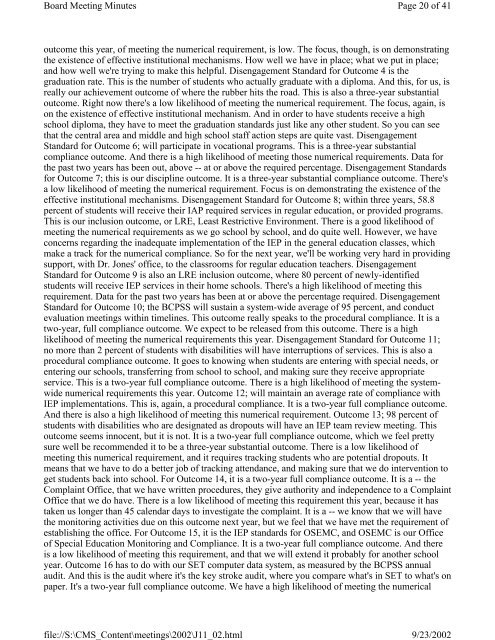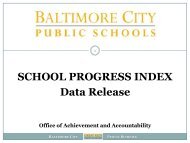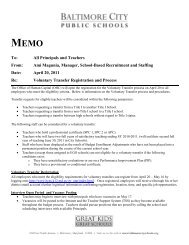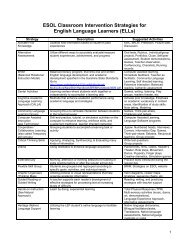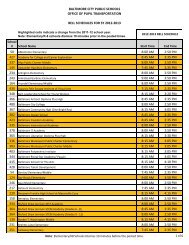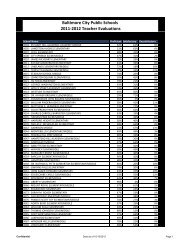June 11, 2002 - Baltimore City Public Schools
June 11, 2002 - Baltimore City Public Schools
June 11, 2002 - Baltimore City Public Schools
You also want an ePaper? Increase the reach of your titles
YUMPU automatically turns print PDFs into web optimized ePapers that Google loves.
Board Meeting Minutes<br />
Page 20 of 41<br />
outcome this year, of meeting the numerical requirement, is low. The focus, though, is on demonstrating<br />
the existence of effective institutional mechanisms. How well we have in place; what we put in place;<br />
and how well we're trying to make this helpful. Disengagement Standard for Outcome 4 is the<br />
graduation rate. This is the number of students who actually graduate with a diploma. And this, for us, is<br />
really our achievement outcome of where the rubber hits the road. This is also a three-year substantial<br />
outcome. Right now there's a low likelihood of meeting the numerical requirement. The focus, again, is<br />
on the existence of effective institutional mechanism. And in order to have students receive a high<br />
school diploma, they have to meet the graduation standards just like any other student. So you can see<br />
that the central area and middle and high school staff action steps are quite vast. Disengagement<br />
Standard for Outcome 6; will participate in vocational programs. This is a three-year substantial<br />
compliance outcome. And there is a high likelihood of meeting those numerical requirements. Data for<br />
the past two years has been out, above -- at or above the required percentage. Disengagement Standards<br />
for Outcome 7; this is our discipline outcome. It is a three-year substantial compliance outcome. There's<br />
a low likelihood of meeting the numerical requirement. Focus is on demonstrating the existence of the<br />
effective institutional mechanisms. Disengagement Standard for Outcome 8; within three years, 58.8<br />
percent of students will receive their IAP required services in regular education, or provided programs.<br />
This is our inclusion outcome, or LRE, Least Restrictive Environment. There is a good likelihood of<br />
meeting the numerical requirements as we go school by school, and do quite well. However, we have<br />
concerns regarding the inadequate implementation of the IEP in the general education classes, which<br />
make a track for the numerical compliance. So for the next year, we'll be working very hard in providing<br />
support, with Dr. Jones' office, to the classrooms for regular education teachers. Disengagement<br />
Standard for Outcome 9 is also an LRE inclusion outcome, where 80 percent of newly-identified<br />
students will receive IEP services in their home schools. There's a high likelihood of meeting this<br />
requirement. Data for the past two years has been at or above the percentage required. Disengagement<br />
Standard for Outcome 10; the BCPSS will sustain a system-wide average of 95 percent, and conduct<br />
evaluation meetings within timelines. This outcome really speaks to the procedural compliance. It is a<br />
two-year, full compliance outcome. We expect to be released from this outcome. There is a high<br />
likelihood of meeting the numerical requirements this year. Disengagement Standard for Outcome <strong>11</strong>;<br />
no more than 2 percent of students with disabilities will have interruptions of services. This is also a<br />
procedural compliance outcome. It goes to knowing when students are entering with special needs, or<br />
entering our schools, transferring from school to school, and making sure they receive appropriate<br />
service. This is a two-year full compliance outcome. There is a high likelihood of meeting the systemwide<br />
numerical requirements this year. Outcome 12; will maintain an average rate of compliance with<br />
IEP implementations. This is, again, a procedural compliance. It is a two-year full compliance outcome.<br />
And there is also a high likelihood of meeting this numerical requirement. Outcome 13; 98 percent of<br />
students with disabilities who are designated as dropouts will have an IEP team review meeting. This<br />
outcome seems innocent, but it is not. It is a two-year full compliance outcome, which we feel pretty<br />
sure well be recommended it to be a three-year substantial outcome. There is a low likelihood of<br />
meeting this numerical requirement, and it requires tracking students who are potential dropouts. It<br />
means that we have to do a better job of tracking attendance, and making sure that we do intervention to<br />
get students back into school. For Outcome 14, it is a two-year full compliance outcome. It is a -- the<br />
Complaint Office, that we have written procedures, they give authority and independence to a Complaint<br />
Office that we do have. There is a low likelihood of meeting this requirement this year, because it has<br />
taken us longer than 45 calendar days to investigate the complaint. It is a -- we know that we will have<br />
the monitoring activities due on this outcome next year, but we feel that we have met the requirement of<br />
establishing the office. For Outcome 15, it is the IEP standards for OSEMC, and OSEMC is our Office<br />
of Special Education Monitoring and Compliance. It is a two-year full compliance outcome. And there<br />
is a low likelihood of meeting this requirement, and that we will extend it probably for another school<br />
year. Outcome 16 has to do with our SET computer data system, as measured by the BCPSS annual<br />
audit. And this is the audit where it's the key stroke audit, where you compare what's in SET to what's on<br />
paper. It's a two-year full compliance outcome. We have a high likelihood of meeting the numerical<br />
file://S:\CMS_Content\meetings\<strong>2002</strong>\J<strong>11</strong>_02.html<br />
9/23/<strong>2002</strong>


